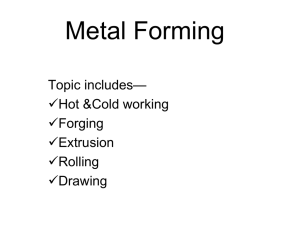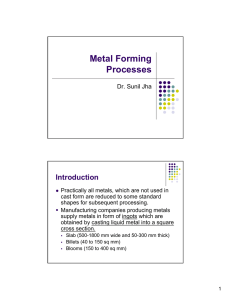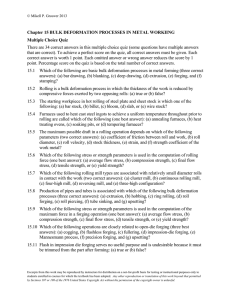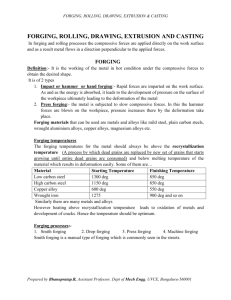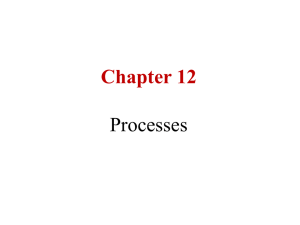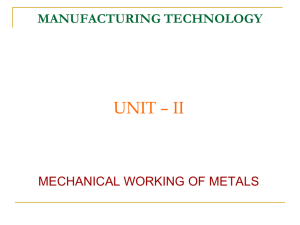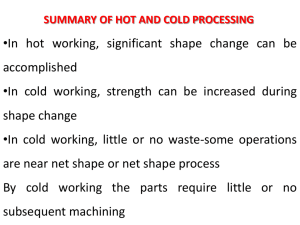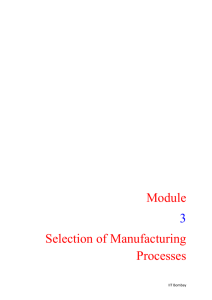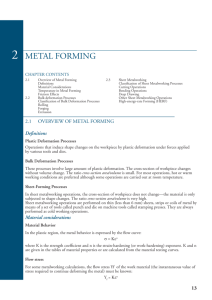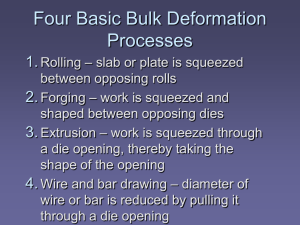Hot and Cold Working - Department of Mechanical Engineering
advertisement
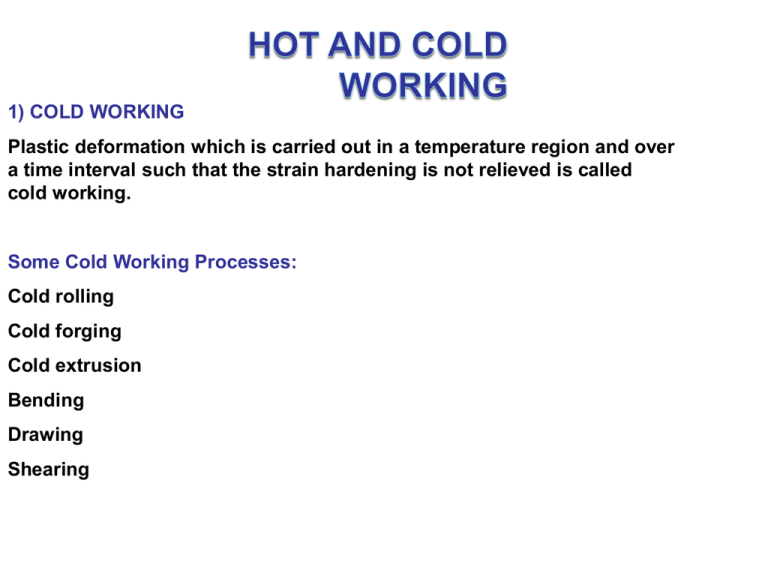
1) COLD WORKING Plastic deformation which is carried out in a temperature region and over a time interval such that the strain hardening is not relieved is called cold working. Some Cold Working Processes: Cold rolling Cold forging Cold extrusion Bending Drawing Shearing Reason for Cold Working: Provides better surface finish and dimensional precision. The advantages of cold working are • A better surface finish may be achieved • Dimensional accuracy can be excellent because the work is not hot so it doesn't shrink on cooling; also the low temperatures mean the tools such as dies and rollers can last a long time without wearing out. • Usually there is no problem with oxidative effects such as scale formation. In fact, cold rolling (for example) can make such scale come off the surface of a previously hot-worked object. • Controlled amounts of cold work may be introduced. Effect of cold working on tensile strength, hardness, ductility and grain size. (The curve below ductility represents the change in grain size) • As with hot working, the grain structure of the material is made to follow the deformation direction, which can be good for the strength of the final product. • Strength and hardness are increased, although at the expense of ductility. • OH & S problems related to working near hot metal are eliminated. • There is a limit to how much cold work can be done on a given piece of metal. See the discussion above about accumulation of damage in the form of piled up dislocations. • Higher forces are required to produce a given deformation, which means we need heavily built, strong forming machines . HOT WORKING • Hot working refers to the process where metals are defromed above their recrystallizatıon tempereture and strain hardening does not occur.Hot working performed at elevated tempreature.However is hot working at room temperature because of its low melting temperature. Hot ingots Some Hot Working Processes: • • • • • • Rolling Forging Extrusion Hot drawing Pipe welding Piercing Reason for Hot Working: At elevated temperatures, metals weaken and become more ductile. The most important continuous hot working processes The advantages of hot working are • Lower working forces to produce a given shape, which means the machines involved don't have to be as strong, which means they can be built more cheaply; • The possibility of producing a very dramatic shape change in a single working step, without causing large amounts of internal stress, cracks or cold working; • Sometimes hot working can be combined with a casting process so that metal is cast and then immediately hot worked. This saves money because we don't have to pay for the energy to reheat the metal. • Hot working tends to break up large crystals in the metal and can produce a favourable alignment of elongated crystals • Hot working can remove some kinds of defects that occur in cast metals. It can close gas pockets (bubbles) or voids in a cast billet; and it may also break up non-metallic slag which can sometimes get caught in the melt (inclusions). The main problems, • If the recrystallisation temperature of the worked metal is high e.g. if we are talking about steel, specialised methods are needed to protect the machines that work the metal. The working processes are also dangerous to human operators and very unpleasant to work near. • The surface finish of hot worked steel tends to be pretty crude because ; the dies or rollers wear quite rapidly there is a lot of dimensional change as the worked object cools there is the constant annoying problem of scale formation on the surface of the hot steel. Forging • Forging is manufacturing process where metal is pressed, pounded or squeezed under great pressure into high strength parts known as forgings. The process is normally (but not always) performed hot by preheating the metal to a desired temperature before it is worked. It is important to note that the forging process is entirely different from the casting (or foundry) process, as metal used to make forged parts is never melted and poured (as in the casting process). 11 12 types of Forging • • • • • • • • Hand forging :- Hand forging is emplayed only to shape a small number of light forgings chiefly in repair shops. Hammer forgings :- Usually used for small item forging. Press forging :- Usually used for heavy item forging. Machine forging :- For medium sized and large articles requiring very heavy blows. Drop forging :- For mass production of identical parts. 13 14 Most open die forgings are produced on flat dies. Round swaging dies and V dies also are used in pairs or with a flat die. Operations performed on open die presses include: • Drawing out or reducing the cross-section of an ingot or billet to lengthen it. • Upsetting or reducing the length of an ingot or billet to a larger diameter. • Upsetting, drawing out, and piercing--processes sometimes combined with forging over a mandrel for forging rough-contoured rings. Forged Products • In automotive applications, forged components are commonly found at points of shock and stress. Forged automobile components include connecting rods, crankshafts, wheel spindles, axle beams, pistons, gears, and steering arms. • Forgings are also used in helicopters, pistonengine planes, commercial jets, and supersonic military aircraft. Many aircraft are "designed around" forgings and contain more than 450 structural forgings, including hundreds of forged engine parts. • "Forged" is the mark of quality in hand tools and hardware. Pliers, hammers, sledgers, wrenches, garden implements, and surgical tools are almost always produced through forging. 17 18 Rolling Aluminium is first passed through a hot rolling mill and then transferred to a cold rolling mill. • Hot rolling mils: Prior to rolling the aluminium is in the form of an ingot which can be up to 600mm thick. This ingot is then heated to around 500°C and passed several times through the hot rolling mill. This gradually reduces the thickness of the metal to around 6mm. • This thinner aluminium is then coiled and transported to the cold rolling mill for further processing. • Cold rolling mils: There are various types of cold rolling mill, and they produce various types of rolled product, with thicknesses as low as 0.05mm. In general the type of product depends on the alloy used, the rolling deformation and thermal treatment used in the process as well as careful adjustments to the mechanics and chemistry of the process. Rolling mills are controlled by very precise mechanisms and measuring systems. 19 20 Rolling is a fabricating process in which the metal, plastic, paper, glass, etc. is passed through a pair (or pairs) of rolls. There are two types of rolling process, flat and profile rolling. In flat rolling the final shape of the product is either classed as sheet (typically thickness less than 3 mm, also called "strip") or plate (typically thickness more than 3 mm). In profile rolling, the final product may be a round rod or other shaped bar such as a structural section (beam, channel, joist etc). Rolling is also classified according to the temperature of the metal rolled. If the temperature of the metal is above its recrystallization temperature then the process is termed as hot rolling, If the temperature of metal is below its recrystallization temperature the process is termed as cold rolling. 23 WHAT is DRAWING? Drawing is an operation in which the cross-section of solid rod, wire or tubing is reduced or changed in shape by pulling it through a die. The principle of this procedure consist of reducing the thickness of a pointed ,tapered wire by drawing it through a conical opening in a tool made of a hard material.The wire will take shape of the hole. • • Drawing improves strength and hardness when these properties are to be developed by cold work and not by subsequent heat treatment Where is it used? This process is widely used for the production of thicker walled seamless tubes and cylinders therefore; shafts, spindles, and small pistons and as the raw material for fasteners such as rivets, bolts, screws. DRAWING TOOLS • The most important tool in the drawing process is without doubt the drawplate.This consist of a plate of high grade steel into which similar shaped holes have been placed whose size in evenly reduced from one hole to another. • The most common drawplate have round holes and are used to reduce the size of round wire. Drawing wire with the draw tongs drawbench How such a drawplate hole is made Deep Drawing Deep drawing and pressing involve a combination of bending and stretching.The simplest example of this process involves the fabrication of a cup from a circular sheet blank. For deep drawing operations the quality of strip required should be non-directional and of the correct combination of hardness and grain size for the tooling . Blanking • • • Blanking is cutting up a large sheet of stock into smaller pieces suitable for the next operation in stamping, such as drawing and forming. Often this is combined with piercing. Blanking can be as simple as a cookie cutter type die to produce prototype parts, or high speed dies that run at 1000+ strokes per minute, running coil stock which has been slit to a specified width. For production parts, the final configuration of the drawn or formed shape needs to be established before the blank die can be built-since the blank size and the slit width size needs to be established precisely. • Piercing • Piercing is the operation of cutting internal features (holes or slots) in stock. Piercing can also be combined with other operations such as lance and form (to make a small feature such as tab), pierce and extrude (to make an extruded hole). All these operations can be combined with blanking. • Piercing of all the holes is best done together to ensure good hole-to-hole tolerance and part repeatability. However if the material distorts, the method described below can be done. • When there are large numbers of holes, in a tight pitch, there could be distortions, due to the high amount of tension on the upper surface due to stretching and compression on the bottom surface. This causes the material not to lay flat. This can be avoided/lessened by staggering the piercing of the holes. Holes are punched in a staggered pattern; then the other holes are punched in the alternate staggered pattern. A material is pushed or drawn through a die of the desired crosssection .Any solid or hollow cross-section may be produced by extrusion, which can create essentially semi-finished parts. The metal can forcing through a die in the same direction or opposite direction. • The cross-sections that can be produced vary from solid round, rectangular, to L shapes, T shapes. • Extrusion may be continuous (theoretically producing indefinitely long material) or semi-continuous (producing many pieces). Extrusions can be done with the material hot or cold. • Commonly extruded materials include metals, polymers, ceramics, and foodstuffs. Extruded products • Typical products made by extrusion are railings for sliding doors, tubing having carious cross-sections, structural and architectural shapes, and door and windows frames. Extruded products • Direct extrusion: A metal billet is located into a container, and a ram compresses the material, forcing it to flow through one or more openings in a die at the opposite end of the container. • Indirect extrusion: The die is mounted to the ram rather than at the opposite end of the container. One advantage of the indirect extrusion process is that there is no friction, during the process, between the billet and the container liner . EXTRUSION PROCESS • • • • The process begins by heating the stock material. It is then loaded into the container in the press. A dummy block is placed behind it where the ram then presses on the material to push it out of the die. Afterwards the extrusion is stretched in order to straighten it. If better properties are required then it may be heat treated or cold worked. The extrusion process is generally economical when producing between several pounds and many tons, depending on the material being extruded. Hot Extrusion Hot extrusion is done at an elevated temperature to keep the material from work hardening and to make it easier to push the material through the die. Most hot extrusions are done on horizontal hydraulic presses that range from 250 to 12,000 tons. The biggest disadvantage of this process is its cost for machinery and its upkeep. Typical parts produced by extrusions are trim parts used in automotive and construction applications, window frame members, railings, aircraft structural parts. Cold Extrusion • • • Cold extrusion is performed at temperatures significantly below the melting temperature of the alloy being deformed, and generally at room temperature. The process can be used for most materials, provided that sufficiently robust machinery can be designed. Products of cold extrusion include aluminium cans, collapsible tubes and gear blanks. The advantages of cold extrusion are: • • • No oxidation takes place Good mechanical properties due to severe cold working as long as the temperatures created are below the re-crystallization temperature Good surface finish with the use of proper lubricants Manufacturing technology PRESENTATION PREPARED BY; • • • • • • Mohammed GHAZAL 042044 Zeynep BELLI 052323 Doga KARACETIN 052330 Ceren ATUN 052302 Cagri KARAPUNAR 052307 Nur FINDIK 052309 40
